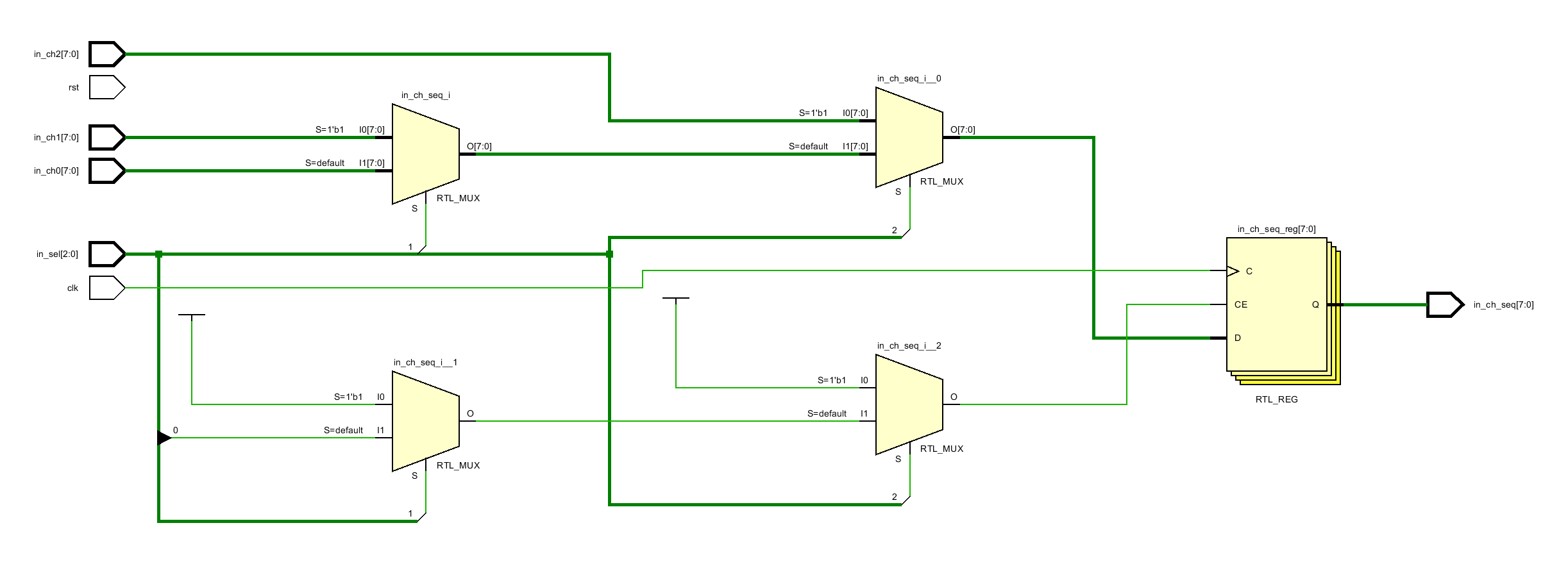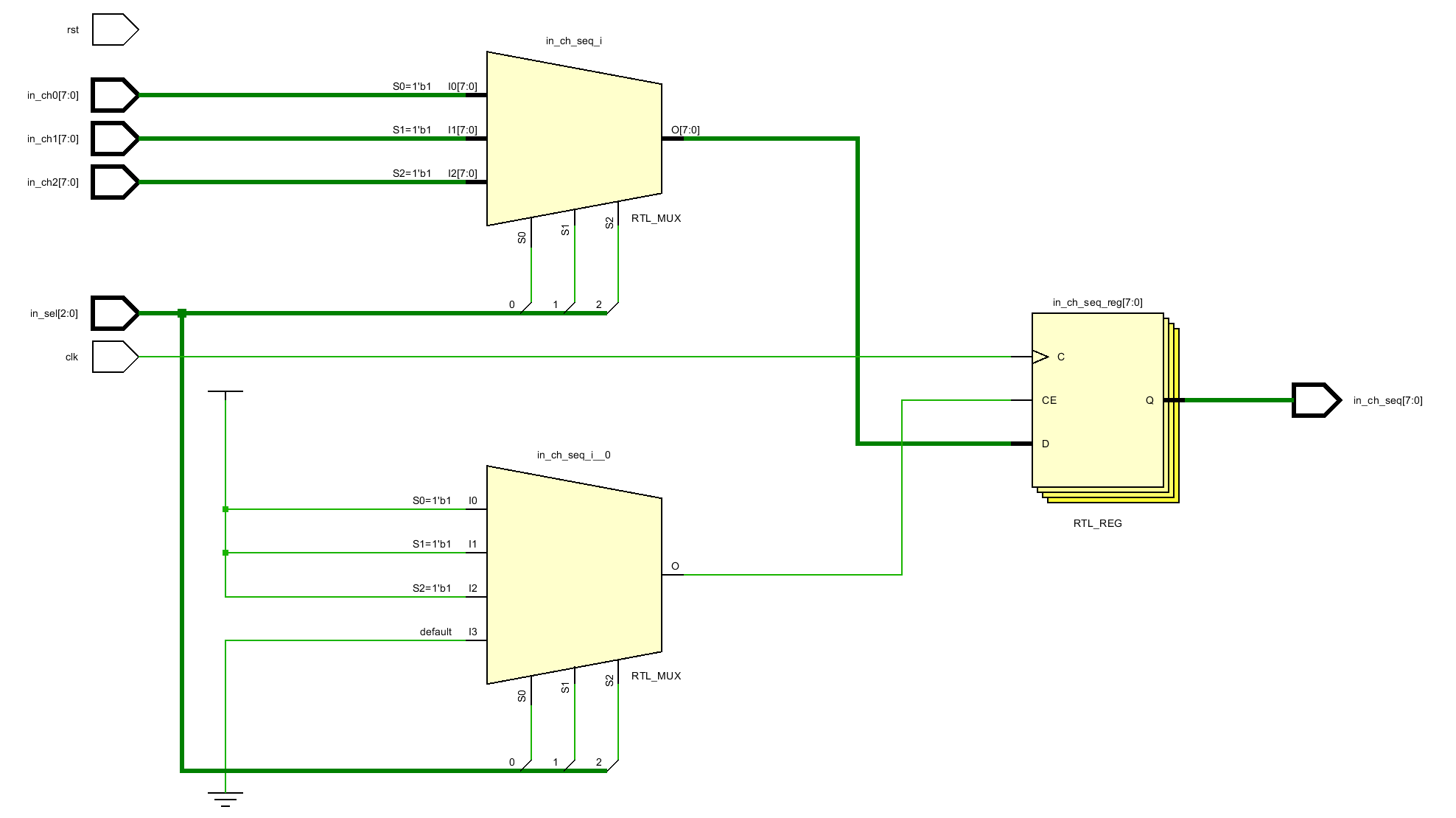【逻辑电路】for循环的等价展开电路
引言
本文讨论如何理解for循环在逻辑电路中的实现。通过各种写法的rtl电路对比,来探讨for循环的等价电路,或者for电路的等价展开电路。
for循环示例
如下给出一个for循环使用的例子,我们来试图理解for循环如何体现在逻辑电路中。
`timescale 1ns / 1ps
module generate_test(
input wire clk ,
input wire rst ,
input wire [2:0] in_sel ,
//
input wire [7:0] in_ch0 ,
input wire [7:0] in_ch1 ,
input wire [7:0] in_ch2 ,
output reg [7:0] in_ch_seq
);
wire [7:0] in_ch[2:0];
assign in_ch[0] = in_ch0;
assign in_ch[1] = in_ch1;
assign in_ch[2] = in_ch2;
//输入数据串行化
// reg [7:0] in_ch_seq;
reg [2:0] i;
always@(posedge clk) begin
for(i = 0; i <= 2; i = i + 1) begin
if(in_sel[i]) begin
in_ch_seq <= in_ch[i];
end
end
end
endmodule
- 1
- 2
- 3
- 4
- 5
- 6
- 7
- 8
- 9
- 10
- 11
- 12
- 13
- 14
- 15
- 16
- 17
- 18
- 19
- 20
- 21
- 22
- 23
- 24
- 25
- 26
- 27
- 28
- 29
- 30
- 31
- 32
- 33
- 34
- 35
很显然,这个逻辑的功能大概就是将并行的输入串行化,这可不必关心。本文的重点是这个for循环怎么理解?
先看它对应的RTL电路:

很容易看出,in_sel的各bit用于选择哪个in_sel输出;
无优先级的if
那既然如此,是不是可以这么实现for循环的替代呢?即
用如下逻辑:
always@(posedge clk) begin
if(in_sel[0]) begin
in_ch_seq <= in_ch[0];
end
if(in_sel[1]) begin
in_ch_seq <= in_ch[1];
end
if(in_sel[2]) begin
in_ch_seq <= in_ch[2];
end
end
- 1
- 2
- 3
- 4
- 5
- 6
- 7
- 8
- 9
- 10
- 11
替换逻辑:
reg [2:0] i;
always@(posedge clk) begin
for(i = 0; i <= 2; i = i + 1) begin
if(in_sel[i]) begin
in_ch_seq <= in_ch[i];
end
end
end
- 1
- 2
- 3
- 4
- 5
- 6
- 7
- 8
我们看下替换后的逻辑电路:

可见, 几乎与for循环写法没有区别,可见,for循环的逻辑电路,可以等价于这种if展开。
问题本科到此结束,但仍需看下其他几种写法;
有优先级的if
always@(posedge clk) begin
if(in_sel[0]) begin
in_ch_seq <= in_ch[0];
end
else if(in_sel[1]) begin
in_ch_seq <= in_ch[1];
end
else if(in_sel[2]) begin
in_ch_seq <= in_ch[2];
end
end
- 1
- 2
- 3
- 4
- 5
- 6
- 7
- 8
- 9
- 10
- 11
相信我们的设计,使用这种写法也可以实现我们的功能,其rtl为:

和上述for循环几乎没有区别,区别仅在于in_sel[0]以及in_ch[0]会被优先判断。
case
使用case写法替换for:
always@(posedge clk) begin
case(1'b1)
in_sel[0]: in_ch_seq <= in_ch[0];
in_sel[1]: in_ch_seq <= in_ch[1];
in_sel[2]: in_ch_seq <= in_ch[2];
default: in_ch_seq <= in_ch_seq;
endcase
end
- 1
- 2
- 3
- 4
- 5
- 6
- 7
- 8
- 9
其rtl电路如下:

我相信仅从功能的角度,这种方式最容易理解。
将for循环的逻辑电路想象成这种形式的电路最容易理解。
总结
从功能的角度来看,上述这几种方式去替代我们的for写法均可,但是有时候,使用for循环最为方便,例如我们的输入特别多,我们使用if,那样会让我们的代码行数非常多,显得臃肿不堪,可效率低下,这时候for循环就可大显身手。
还有一个问题就是为什么我们的示例,不是仅为单纯的for,还加入了if,有多方面的考虑:
一方面,是这样看起来我们的for循环更像是一个多驱动的电路,可实际并非如此,可见我们的等价写法;
另一方面,更多的趣味性(没必要找更多有点了)。
最后,不免有人抬杠,说有漏洞之类,没关系,你是对的。
需要之人,自能得到其价值,用于自身。
文章来源: reborn.blog.csdn.net,作者:李锐博恩,版权归原作者所有,如需转载,请联系作者。
原文链接:reborn.blog.csdn.net/article/details/124226809
- 点赞
- 收藏
- 关注作者


评论(0)